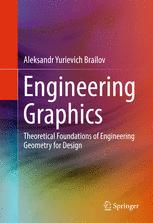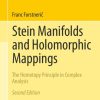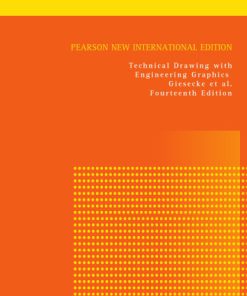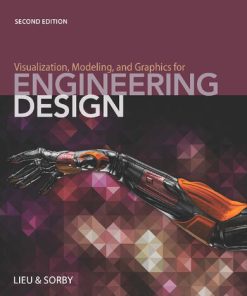Engineering Graphics Theoretical Foundations of Engineering Geometry for Design 1st Edition by Aleksandr Yurievich Brailov 3319297194 9783319297194
$50.00 Original price was: $50.00.$25.00Current price is: $25.00.
Engineering Graphics Theoretical Foundations of Engineering Geometry for Design 1st Edition by Aleksandr Yurievich Brailov – Ebook PDF Instant Download/DeliveryISBN: 3319297194, 9783319297194
Full download Engineering Graphics Theoretical Foundations of Engineering Geometry for Design 1st Edition after payment.

Product details:
ISBN-10 : 3319297194
ISBN-13 : 9783319297194
Author: Aleksandr Yurievich Brailov
This professional treatise on engineering graphics emphasizes engineering geometry as the theoretical foundation for communication of design ideas with real world structures and products. It considers each theoretical notion of engineering geometry as a complex solution of direct- and inverse-problems of descriptive geometry and each solution of basic engineering problems presented is accompanied by construction of biunique two- and three-dimension models of geometrical images. The book explains the universal structure of formal algorithms of the solutions of positional, metric, and axonometric problems, as well as the solutions of problems of construction in developing a curvilinear surface. The book further characterizes and explains the added laws of projective connections to facilitate construction of geometrical images in any of eight octants. Laws of projective connections allow constructing the complex drawing of a geometrical image in the American system of measurement and the European system of measurement without errors and mistakes. The arrangement of projections of a geometrical image on the complex drawing corresponds to an arrangement of views of a product in the projective drawing for the European system of measurement. The volume is ideal for engineers working on a range of design projects as well as for students of civil, structural, and industrial engineering and engineering design.
Engineering Graphics Theoretical Foundations of Engineering Geometry for Design 1st Table of contents:
1 Descriptive Geometry
1.1 The Subject Matter of Descriptive Geometry
1.2 Aims and Problems of Descriptive Geometry
1.3 Types of Geometric Figures and Objects (Images)
1.4 A Determinant of a Geometric Image (Object)
1.5 A Projecting Method. The Components and the Operations of Projection
References
2 Types of Projection. The Center of Projection
2.1 Central (conical) Projection
2.2 Parallel (cylindrical) Projection
2.3 Properties of the Central (conic) Projection
2.4 Properties of Parallel (cylindrical) Oblique-Angled Projection
2.5 Properties of Parallel Rectangular (orthogonal) Projection
References
3 Formation of the Complex Drawing. Octants. The Method of Gaspard Monge
3.1 The Concept of Octant
3.2 The Essence of the Method of Gaspard Monge
References
4 Geometrical Models and an Analytical Model of a Point
4.1 The Laws of Projective Connections
4.2 Classification of Points
4.3 Review Questions on the First Block (Chaps. 1–4)
References
5 Geometric and Analytical Models of a Straight Line
5.1 Classification of Straight Lines
5.2 Ways of Representation for a Line Segment and Determinants of a Straight Line
5.3 Geometric Model of a Straight Line of General Position
5.4 The Peculiarities of a Complex Drawing of a Straight Line of General Position
5.5 Geometric Models of a Level Line
5.5.1 A Geometric Model of a Horizontal Level Line and Properties of This Model
5.5.2 A Geometric Model of a Frontal Level Line and Properties of This Model
5.5.3 A Geometric Model of a Profile Level Line and Properties of This Model
5.5.4 Peculiarities of the Complex Drawing of a Level Line
5.6 Geometric Models of a Projecting Straight Line
5.6.1 A Geometric Model of a Horizontally Projecting Straight Line and Properties of the Model
5.6.2 A Geometric Model of a Frontally Projecting Straight Line and Properties of This Model
5.6.3 A Geometric Model of a Profiled Projecting Straight Line and Properties of the Model
5.6.4 Peculiarities of the Complex Drawing of a Projecting Straight Line
5.7 Analytical Models of a Straight Line
References
6 Geometric Models and Analytical Models of a Plane
6.1 Classification of Planes
6.2 Ways of Representation of a Plane in the Complex Drawing. Plane Determinants
6.3 A Geometric Model of a Plane of General Position
6.4 Peculiarities of the Complex Drawing of a Plane of General Position
6.5 Geometric Models of a Plane of Level
6.5.1 A Geometric Model of a Horizontal Plane of Level and Properties of This Model
6.5.2 A Geometric Model of a Frontal Plane of Level and Properties of This Model
6.5.3 A Geometric Model of a Profile Plane of Level and Properties of This Model
6.5.4 Peculiarities of the Complex Drawing of a Plane of Level
6.6 Geometric Models of a Projecting Plane
6.6.1 A Geometric Model of a Horizontally Projecting Plane and Properties of This Model
6.6.2 A Geometric Model of a Frontally Projecting Plane and Properties of This Model
6.6.3 A Geometric Model of a Profiled Projecting Plane and Properties of This Model
6.6.4 Peculiarities of the Complex Drawing of a Projecting Plane
6.7 Analytical Models of a Plane
6.8 The Main Lines of a Plane
6.9 Review Questions for Chap. 5 and this Chapter
References
7 Geometric and Analytical Models of a Surface
7.1 Ways of Formation, Description and Mapping, and Classification of Surfaces
7.2 A Surface Contour and a Surface Sketch. The Way of Representing a Surface in a Complex Drawing
7.3 Ruled Developable Surfaces with One Directional Line
7.4 Ruled Undevelopable Surfaces with Two Directional Lines and a Plane of Parallelism
7.5 Ruled Undevelopable Surfaces with Three Directional Lines
7.6 Screw Surfaces
7.7 Surfaces of Revolution and Their Analytical Models
7.8 An Indication of a Point Belonging to a Surface
7.9 Review Questions the Third Block (This Chapter)
References
8 Positional Problems
8.1 The Concept and Classification of Positional Problems
8.2 The Concept of Competing Points. The Rule to Define the Visibility of Constructive Elements of a
8.3 Mutual Location, Intersection and Belonging of the Same Linear Geometric Images to Each Other
8.3.1 Mutual Location, Intersection and Belonging of Points to Each Other. The Rule to Define the Vi
8.3.2 Mutual Location, Intersection and Belonging of Straight Lines to Each Other
8.3.3 Mutual Location, Intersection and Belonging of Planes to Each Other
8.4 Mutual Location, Intersection and Belonging of Different Types of Linear Geometric Images to Eac
8.4.1 Mutual Location, Intersection and Belonging of a Point and a Straight Line
8.4.2 Mutual Location, Intersection and Belonging of a Point and a Plane
8.4.3 Mutual Location, Intersection and Belonging of a Straight Line and a Plane
8.5 Mutual Location, Intersection and Belonging of a Point and a Surface
8.6 Application of the Indications of Incidence of Geometric Images to Solve Engineering Problems
8.6.1 A Problem of Belonging of a Straight Line to a Plane (Problem 1)
8.6.2 The Problem of a Point Belonging to the Plane (Problem 2)
8.6.3 The Problem of Parallel Planes (Problem 3)
8.7 Mutual Intersection of Geometric Images
8.7.1 Classification of Positional Problems of Mutual Intersection of Geometric Images
8.7.2 The Concept and Criterion of a Choice of the Intermediary for Positional Problems
8.7.3 Algorithm for Solving Positional Problems of Mutual Intersection of Geometric Images
8.7.4 Construction of a Point of Intersection of a Straight Line and a Plane (Problems 4, 5). The Fi
8.7.5 Construction of a Line of Intersection of Two Planes (Problem 6). The Second Basic Positional
8.7.6 Construction of Points of Intersection of a Straight Line and a Surface (Problem 7)
8.7.7 Construction of the Line of Intersection of a Plane and a Surface (Problem 8)
8.7.8 Construction of the Line of Intersection of Two Surfaces (Problems 9, 10, 11)
8.8 Review Questions to the Fourth Block (Chapter 8)
References
9 Metric Problems
9.1 The Theorem of a Right Angle Projection
9.2 Solving Metric Problems Without Transformation of the Complex Drawing
9.2.1 Perpendicularity of Straight Lines (Problems 1, 2)
9.2.2 Perpendicularity of a Straight Line and a Plane (Problem 3)
9.2.3 Perpendicularity of Two Planes
9.2.4 Angles Between Straight Lines
9.2.5 Angle Between a Straight Line and a Plane (Problem 4)
9.2.6 Angle Between Planes
9.3 Solving Metric Problems by Means of Complex Drawing Transformation
9.3.1 Classification of Transformation Methods of the Complex Drawing of a Geometric Image
9.3.2 Methods of Complex Drawing Transformation for a Motionless Geometric Image
9.3.2.1 A Method of Change of Projection Planes with Introduction of Planes and Coordinate Axes Out
9.3.2.2 A Method of Change of Projection Planes Introducing the Planes and Axes of Coordinates Throu
9.3.2.3 Algorithm of Multiple Application of the Method of Change of Projection Planes
9.3.3 Methods of Transformation of Complex Drawing in Changeable (Mobile) Position of Geometric Imag
9.3.3.1 Rotation Method of Geometric Image Around a Straight Line (Axis) of General Position
9.3.3.2 Rotation Method of a Geometric Image Around a Straight Line, Perpendicular to the Projection
9.3.3.3 A Method of Rotation of a Geometric Image Around a Straight Line of Level (Problem 8)
9.3.3.4 A Method of Coincidence of a Plane of General Position with Projection Planes by Means of Ro
9.3.3.5 Method of Plane-Parallel Moving (Problem 10)
9.4 Review Questions on the Fifth Block (This Chapter)
References
10 Development of Surfaces
10.1 Basic Properties of Development
10.2 A Condition of Surface Development
10.3 The General Principle, Method and Algorithm for Constructing Development of a Curvilinear Devel
10.4 Methods of Constructing Development
10.5 Development of Cones and Pyramids (Problem 1)
10.6 Development of Cylinders and Prisms (Problem 2)
10.7 Review Questions on the Sixth Information Block (This Chapter)
References
11 Axonometric Projections
11.1 The Projection Drawing. Requirements for the Projective Drawing and Its Construction
11.2 Principles of Construction of a Drawing
11.3 Axonometry Definition
11.4 The Essence, the Components and Operations of the Method of Axonometric Projection
11.5 Properties of Axonometric Projections
11.5.1 Visualization of Axonometric Projections
11.5.2 Convertibility of Axonometric Projections
11.5.3 Measurability of Axonometric Projections
11.6 The Polke-Schwarz Theorem
11.7 Classification of Axonometric Projections
11.8 Standard Kinds of Axonometric Projections
11.8.1 A Rectangular Isometry
11.8.2 Rectangular Dimetry
11.8.3 Oblique-Angled Frontal Isometry
11.8.4 Oblique-Angled Frontal Dimetry
11.8.5 Oblique-Angled Horizontal Isometry
11.9 Algorithm of Construction of Axonometric Projections
11.10 Review Questions on the Seventh Block (This Chapter)
References
12 Conclusion and Summary
12.1 The Collection of Recent Developments
References
People also search for Engineering Graphics Theoretical Foundations of Engineering Geometry for Design 1st:
engineering graphics 1
engineering graphics tools for the mind pdf
engineering graphics tools for the mind
engineering graphics text and workbook
a concise introduction to engineering graphics 6th edition answers
Tags: Engineering Graphics, Theoretical Foundations, Engineering Geometry, Design, Aleksandr Yurievich Brailov
You may also like…
Mathematics
SF1624 Algebra and Geometry Introduction to Linear Algebra for Science Engineering Daniel Norman
Computers - Computer Graphics & Design
Education Studies & Teaching
Learning Engineering for Online Education Theoretical Contexts and Design Based Examples Chris Dede
Arts - Architecture
Computers - Programming












